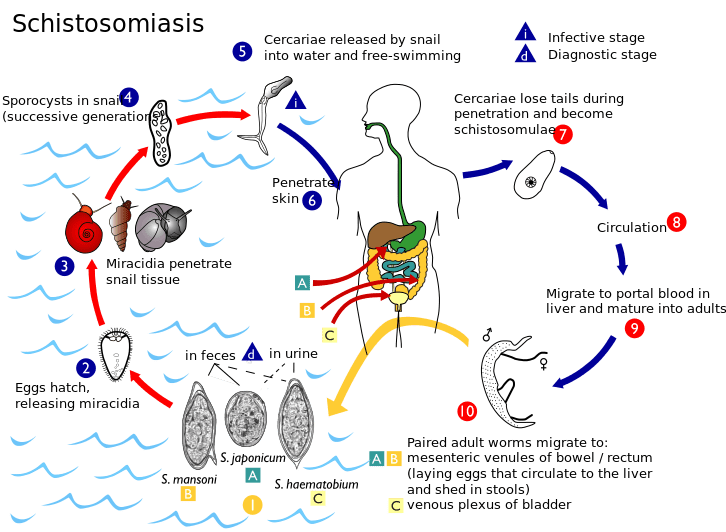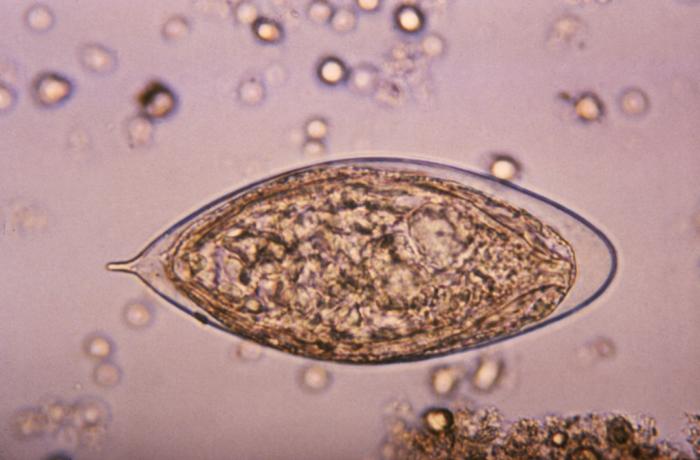Difference Between Schistosoma Mansoni and Haemotobium
Key Difference – Schistosoma Mansoni vs Haemotobium
Schistosoma is a group of trematodes that are known as blood flukes because they live inside the blood vessels. Schistosoma Mansoni and Haemotobium are two organisms belonging to this group that enter into the human circulation by penetrating the overlying skin. Schistosoma Mansoni predominantly causes GI infections whereas Hemotobium mostly causes urinary tract or bladder infections. This is the main difference between Schistosoma Mansoni and Haemotobium.
CONTENTS
1. Overview and Key Difference
2. What is Schistosoma Mansoni
3. What is Haemotobium
4. Similarities Between Schistosoma Mansoni and Haemotobium
5. Side by Side Comparison – Schistosoma Mansoni vs Haemotobium in Tabular Form
6. Summary
What is Schistosoma Mansoni?
Schistosoma is a group of trematodes that causes a set of symptoms and signs that are identified as schistosomiasis. Schistosoma Mansoni is one organism of this large group of organisms, and it causes gastrointestinal infections.
These organisms live in the mesenteric veins and are known as the blood flukes.
Humans are infected during swimming in free water. The fork-tailed cercariae penetrate the skin and differentiate into larvae. Then they enter the arterial circulation after passing through the venous blood. Organisms that enter the superior mesenteric circulation pass into the liver via portal circulation. In the definitive venous site, females lay eggs, which enter the gut lumen and pass into the fresh water via feces to be hatched. Once hatched, the ciliated larvae enter the snails and mature into cercariae that penetrate the human skin again to complete the life cycle.

Figure 01: Life Cycle of Schistosoma
Pathogenesis
Clinical Findings
- Most patients are asymptomatic.
- Immediately after the penetration of cercariae, there will be itching and dermatitis, which is followed by fever, chills, diarrhoea, lymphadenopathy, and Hepatosplenomegaly after a duration of 2-3 weeks.
- In the chronic stage, the patients can develop gastrointestinal hemorrhages, hepatomegaly, and massive splenomegaly. Patients can die because of the exsanguination from ruptured esophageal varices.
Laboratory Diagnosis
Definitive diagnosis is through the identification of the presence of eggs in stool or urine samples.
Management
All forms of schistosomiasis are treated with praziquantel.
What is Haemotobium?
Haemotobium is another organism of the Schistosoma family that infects the human bladder. Its life cycle is same as that of Mansoni, but the Haemotobium enters the human bladder instead of gut. The eggs are laid in the bladder and are added to freshwater with urine.
The Haemotobium eggs in the bladder can induce granuloma formation and fibrosis which can ultimately end up as bladder carcinoma.

Figure 02: A Haemotobium Egg
In addition to the clinical features mentioned above, Hemotobium infection of the bladder can give rise to features of lower urinary tract infections such as dysuria, hematuria and urinary tract obstruction in long-standing infections.
What are the Similarities Between Schistosoma Mansoni and Haemotobium?
- Both belong the same genus.
- The life cycle of the organisms is the same.
- They share similar mechanisms of pathogenesis and clinical features.
- Infections by both these organisms are managed by the administration of praziquantel.
What is the Difference Between Schistosoma Mansoni and Haemotobium?
Schistosoma Mansoni vs Haemotobium | |
| Schistosoma Mansoni causes gut infections. | Haemotobium causes bladder infections. |
| Eggs | |
| Eggs are added to the water via stools. | Eggs are added to the water via urine. |
| Passage | |
| Organisms pass through the superior mesenteric circulation into the portal circulation. | Haemotobium passes through the venous plexus between the rectum and bladder. |
Summary – Schistosoma Mansoni vs Hemotobium
Both Schistosoma Mansoni and Schistosoma Hemotobium are trematodes. The principal difference between Schistosoma Mansoni and Haemotobium is that Schistosoma Mansoni causes gastrointestinal organisms, but Haemotobium causes urinary tract and bladder infections.
Reference:
1. Jawetz, Ernest, et al. Review of medical microbiology. Appleton & Lange, 1987.
Image Courtesy:
1. “Schistosoma life cycle” By CDC – (CC0) via Commons Wikimedia
2. “Schistosoma haematobium egg 4843 lores” By CDC, Public Health Image Library (PHIL) – (Public Domain) via Commons Wikimedia
ncG1vNJzZmivp6x7pbXFn5yrnZ6YsqOx07CcnqZemLyue8OinZ%2Bdopq7pLGMm5ytr5Wau26%2FwqGgrKyfqLyurYymmKern6O2bq3NnWSvq12drqa5zq2mm6Glonw%3D